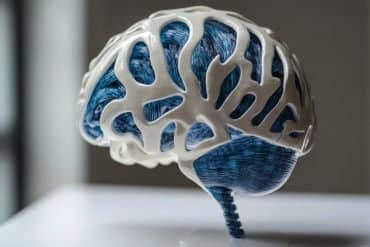Summary: Researchers identified brain regions and neuron types crucial for learning from negative experiences. They found that inhibitory neurons in the horizontal limb of the diagonal band of Broca (HDB) play a significant role in this process.
Using optogenetics, they demonstrated that these neurons are essential for associative learning from aversive stimuli, highlighting their importance in attention and learning. This discovery provides insights into how negative experiences shape behavior and learning.
Key Facts:
- HDB-PV neurons, found in a deep brain nucleus, are vital for learning from negative experiences.
- These neurons increase cortical excitability through disinhibition, aiding in associative learning.
- Optogenetic experiments showed that blocking HDB-PV neurons impairs learning from aversive stimuli.
Source: Institute for Experimental Medicine
‘I’m not gonna do this again’, we often say when faced with negative feedback, adverse effects, or disappointing outcomes. Thus, we attempt to learn from such negative experiences.
This principle is also a cornerstone of our education system: failing an exam ought to encourage students to do better next time.
How does the brain achieve this type of learning? Positive and negative reinforcement appear as two sides of the same coin in parts of the brain’s valuation system.

Notably, some neurons that release the neuromodulator ‘dopamine’ represent outcomes better vs. worse than expected with increase or decrease of their activity, respectively.
At the same time, ample accumulating evidence suggests that other parts of the brain handle ‘negative’ and ‘positive’ fundamentally differently.
Negative experiences, when encountered, often have an arousing effect: they do not leave us indifferent or heedless.
Beyond this general arousal, specific parts of the neocortex are activated that allow us to pay attention to relevant features, and eventually, draw consequences and learn – a concept sometimes called ‘attention for learning’.
When focusing on the negative side of things, we may coin this ‘attention for aversive learning’.
A team of neuroscientists at the HUN-REN Institute of Experimental Medicine Budapest, Hungary, led by Principal Investigator Balazs Hangya MD PhD, asked which brain regions and neuron types might be responsible for ‘attention for aversive learning’.
In a new study published today in Nature Communications, the team reports that long-range projecting inhibitory neurons that express the calcium-binding protein parvalbumin (PV) known for their capabilities of very fast activity, located in a deep brain nucleus called ‘the horizontal limb of the diagonal band of Broca’ or HDB play a key role in this process.
These HDB-PV neurons have previously been shown to convey arousing effects to the neocortex at both short and long time scales, and control fast cortical brain waves called gamma oscillations important for cognitive processes. Therefore, they appeared as good candidates for mediating ‘attention for aversive learning’.
Hangya’s team showed that these neurons are indeed recruited by aversive events in experimental mice, like an unexpected puff of air on the face mice strive to avoid, or the odor of a fearful predator.
Such aversive events are obviously relevant for humans and animals alike, and thus activate a number of pathways evoking a series of consequences in the brain.
First and maybe foremost, these events may represent a chance of lasting negative impact or even immediate danger, the probability of which should be mitigated by avoidance behaviors. Indeed, many of the neural pathways recruited by aversive inputs were found to drive active avoidance.
Second, unexpected aversive events should increase arousal and attention by activating relevant parts of the neocortex, thus recruiting resources that enable coping with the situation.
Third and crucial for survival in the long run, aversive events should induce learning to help avoid or reduce the impact of similar scenarios in the future.
‘Learning from negative experience is a deeply rooted, ancient strategy of survival. It is so strong that we, ourselves might experience sometimes that it can even override the effect of positive reinforcement’ adds Panna Hegedüs, first author of the study.
Hangya’s team used a technology called optogenetics, which can render specific cell types, in this case HDB-PV neurons, sensitive to light. These techniques enable precise activation or suppression of the activity of neurons by the timed delivery of light into the brain tissue via small optic fibers.
They found that activating HDB-PV neurons did not cause avoidance behavior in mice, suggesting that this pathway is not involved in active avoidance like seeking a shelter, but more likely mediates attention and/or learning aspects induced by aversive stimuli.
Indeed, when they optogenetically blocked the responses of the neurons to facial air puffs, mice failed to learn discriminating predictive auditory stimuli forecasting likely or unlikely air puffs. This experiment demonstrated that HDB-PV neurons are necessary to learn from aversive stimuli.
What brain circuit mediates this learning effect? Neurons do not act in isolation but are part of complex circuits with diverse input and output pathways. Hangya’s team, together with Gabor Nyiri and coworkers from the same institute, mapped the inputs to and outputs of HDB-PV neurons.
They found that these cells integrate multiple sources of aversive information including prominent pathways from the hypothalamus and the brainstem raphe nuclei. In turn, they transmit integrated information to the so-called limbic system broadly responsible for behavioral and emotional responses, including the septo-hippocampal system important for storing and recalling episodic memories.
Furthermore, the inhibitory HDB-PV cells mostly target other inhibitory neurons in these regions, thus likely relieving excitatory cells from inhibition allowing them to be more active – a ubiquitous brain mechanism called disinhibition.
In sum, the study suggests that long-range inhibitory HDB-PV neurons are recruited by aversive stimuli to serve crucial associative learning functions through increasing cortical excitability at specific target areas, probably by disinhibition. Thus, at least for aversive stimuli, HDB-PV neurons might be the physical substrate of the ‘attention for learning’ concept.
‘The dysregulation of processing positive and negative valence can be observed in different psychiatric disorders including anxiety and depression. Therefore, it is crucial to understand how negative valence is encoded in the brain and how it contributes to learning’, Panna Hegedüs concludes.
About this learning and neuroscience research news
Author: Marta Turek
Source: Institute for Experimental Medicine
Contact: Marta Turek – Institute for Experimental Medicine
Image: The image is credited to Neuroscience News
Original Research: Open access.
“Parvalbumin-expressing basal forebrain neurons mediate learning from negative experience” by Balazs Hangya et al. Nature Communications
Abstract
Parvalbumin-expressing basal forebrain neurons mediate learning from negative experience
Parvalbumin (PV)-expressing GABAergic neurons of the basal forebrain (BFPVNs) were proposed to serve as a rapid and transient arousal system, yet their exact role in awake behaviors remains unclear.
We performed bulk calcium measurements and electrophysiology with optogenetic tagging from the horizontal limb of the diagonal band of Broca (HDB) while male mice were performing an associative learning task.
BFPVNs responded with a distinctive, phasic activation to punishment, but showed slower and delayed responses to reward and outcome-predicting stimuli.
Optogenetic inhibition during punishment impaired the formation of cue-outcome associations, suggesting a causal role of BFPVNs in associative learning.
BFPVNs received strong inputs from the hypothalamus, the septal complex and the median raphe region, while they synapsed on diverse cell types in key limbic structures, where they broadcasted information about aversive stimuli.
We propose that the arousing effect of BFPVNs is recruited by aversive stimuli to serve crucial associative learning functions.






